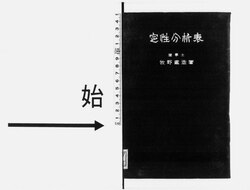File:NDL1109181 定性分析表.pdf

Original file (5,627 × 4,277 pixels, file size: 15.05 MB, MIME type: application/pdf, 36 pages)
Captions
Captions
Summary
[edit]| 定性分析表
( |
|||||||||||||||||||||||||||
|---|---|---|---|---|---|---|---|---|---|---|---|---|---|---|---|---|---|---|---|---|---|---|---|---|---|---|---|
| Author |
牧野, 鑑造 |
||||||||||||||||||||||||||
| Title |
定性分析表 |
||||||||||||||||||||||||||
| Publisher |
前野書店 |
||||||||||||||||||||||||||
| Language | jpn | ||||||||||||||||||||||||||
| Publication date |
1938 昭和13 |
||||||||||||||||||||||||||
| Place of publication | JP | ||||||||||||||||||||||||||
| Source |
institution QS:P195,Q477675 |
||||||||||||||||||||||||||
| Creator InfoField | 牧野鑑造 著 | ||||||||||||||||||||||||||
| Publication Place InfoField | 東京 | ||||||||||||||||||||||||||
| Subject: NDC InfoField | 433 | ||||||||||||||||||||||||||
| Extent InfoField | 56p ; 23cm | ||||||||||||||||||||||||||
| Material Type InfoField | Book | ||||||||||||||||||||||||||
| Source Identifier: JPNO InfoField | 44058652 | ||||||||||||||||||||||||||
| Date Digitized: W3CDTF InfoField | 2010-03-31 | ||||||||||||||||||||||||||
| Audience InfoField | 一般 | ||||||||||||||||||||||||||
| Title Transcription InfoField | テイセイ ブンセキヒョウ | ||||||||||||||||||||||||||
| Publisher Transcription InfoField | マエノ ショテン | ||||||||||||||||||||||||||
| Source Identifier: NDLBibID InfoField | 000000654290 | ||||||||||||||||||||||||||
| Call Number InfoField | 特238-135 | ||||||||||||||||||||||||||
| Creator Transcription: NDLNA InfoField | マキノ, カンゾウ | ||||||||||||||||||||||||||
| Creator: NDLNAId InfoField | 00039802 | ||||||||||||||||||||||||||
| Available: internet InfoField | 2023-01-04 | ||||||||||||||||||||||||||
| Contents InfoField | 標題
第一族陽性イオンを他のイオンより分離し且つ之を檢出する法 第一表/21 第一族陽性イオンを含まざる可檢液より第二族陽性イオンを分離し且つ之を檢出する法 第二表/23 第一・第二族を含まざる可檢液より第三族陽性イオンを分離し且つ之を檢出する法 第三表/27 第四・第五族イオンのみを含む溶液より第四族陽性イオンを分離し且つ之を檢出する法 第四表/33 第五族陽性イオンのみを含む溶液より各イオンを檢出する法 第五表/35 附録 元素の常用原子量表/56 |
||||||||||||||||||||||||||
Licensing
[edit]This image is in the public domain because it is a mere mechanical scan or photocopy of a public domain original, or – from the available evidence – is so similar to such a scan or photocopy that no copyright protection can be expected to arise. The original itself is in the public domain for the following reason:
This tag is designed for use where there may be a need to assert that any enhancements (eg brightness, contrast, colour-matching, sharpening) are in themselves insufficiently creative to generate a new copyright. It can be used where it is unknown whether any enhancements have been made, as well as when the enhancements are clear but insufficient. For known raw unenhanced scans you can use an appropriate {{PD-old}} tag instead. For usage, see Commons:When to use the PD-scan tag. |
File history
Click on a date/time to view the file as it appeared at that time.
| Date/Time | Thumbnail | Dimensions | User | Comment | |
|---|---|---|---|---|---|
| current | 11:26, 16 November 2023 |  | 5,627 × 4,277, 36 pages (15.05 MB) | Wmr-bot (talk | contribs) | 上載《1109181.pdf》 |
You cannot overwrite this file.
File usage on Commons
The following page uses this file:
Metadata
This file contains additional information such as Exif metadata which may have been added by the digital camera, scanner, or software program used to create or digitize it. If the file has been modified from its original state, some details such as the timestamp may not fully reflect those of the original file. The timestamp is only as accurate as the clock in the camera, and it may be completely wrong.
| Short title | |
|---|---|
| Author | |
| Keywords | https://commons.wikimedia.org/wiki/Commons:Library_back_up_project |
| Conversion program | PyPDF2 |
| Encrypted | yes (print:yes copy:no change:no addNotes:no algorithm:AES-256) |
| Page size | 2701.5 x 2053.5 pts |
| Version of PDF format | 1.7 |




